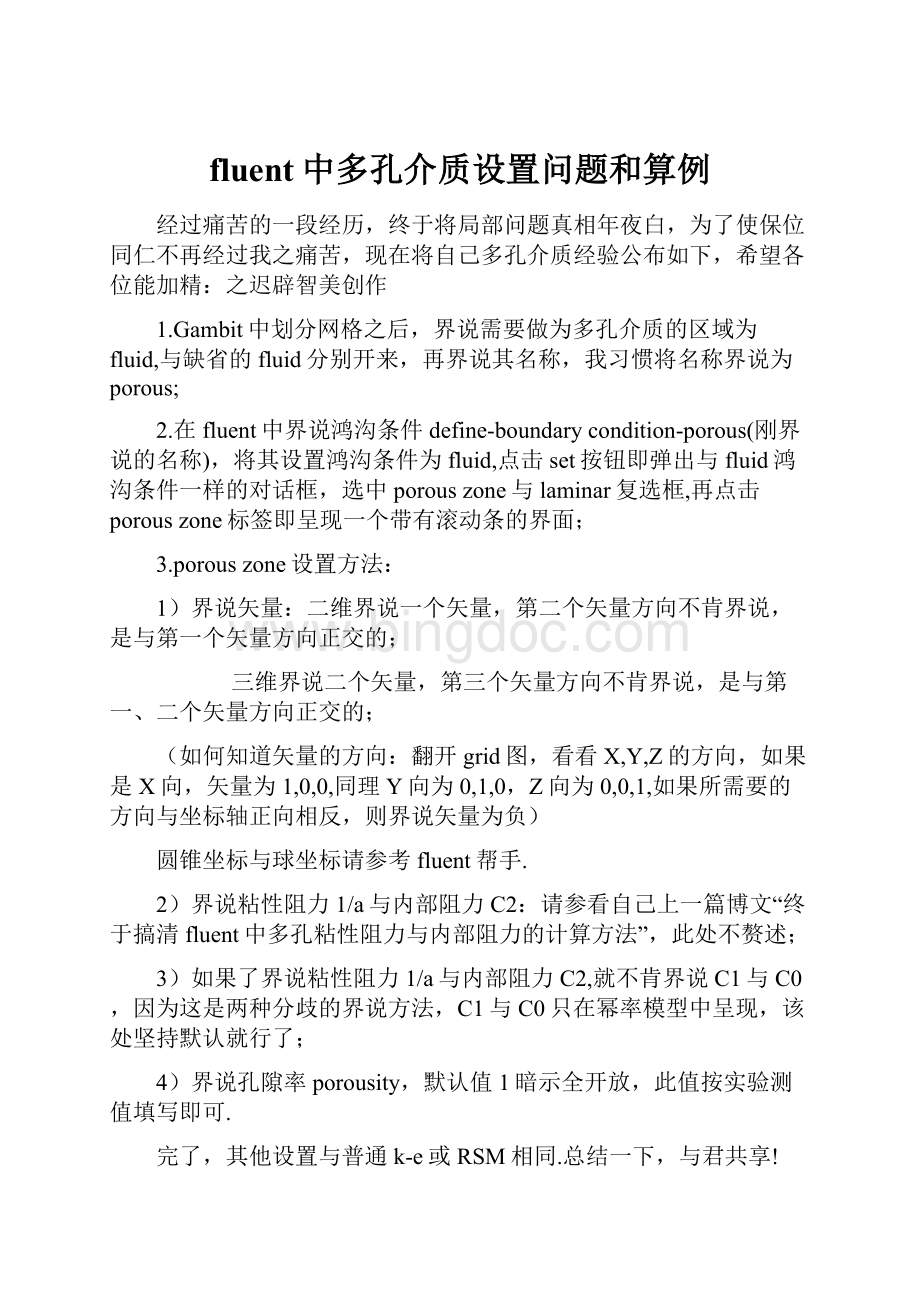fluent中多孔介质设置问题和算例Word文件下载.docx
《fluent中多孔介质设置问题和算例Word文件下载.docx》由会员分享,可在线阅读,更多相关《fluent中多孔介质设置问题和算例Word文件下载.docx(12页珍藏版)》请在冰点文库上搜索。

3)如果了界说粘性阻力1/a与内部阻力C2,就不肯界说C1与C0,因为这是两种分歧的界说方法,C1与C0只在幂率模型中呈现,该处坚持默认就行了;
4)界说孔隙率porousity,默认值1暗示全开放,此值按实验测值填写即可.
完了,其他设置与普通k-e或RSM相同.总结一下,与君共享!
Tutorial7.ModelingFlowThroughPorousMedia
Introduction
Manyindustrialapplicationsinvolvethemodelingofflowthroughporousmedia,suchasfilters,catalystbeds,andpacking.Thistutorialillustrateshowtosetupandsolveaprobleminvolvinggasflowthroughporousmedia.
Theindustrialproblemsolvedhereinvolvesgasflowthroughacatalyticconverter.Catalyticconvertersarecommonlyusedtopurifyemissionsfromgasolineanddieselenginesbyconvertingenvironmentallyhazardousexhaustemissionstoacceptablesubstances.
Examplesofsuchemissionsincludecarbonmonoxide(CO),nitrogenoxides(NOx),andunburnedhydrocarbonfuels.Theseexhaustgasemissionsareforcedthroughasubstrate,whichisaceramicstructurecoatedwithametalcatalystsuchasplatinumorpalladium.
Thenatureoftheexhaustgasflowisaveryimportantfactorindeterminingtheperformanceofthecatalyticconverter.Ofparticularimportanceisthepressuregradientandvelocitydistributionthroughthesubstrate.HenceCFDanalysisisusedtodesignefficientcatalyticconverters:
bymodelingtheexhaustgasflow,thepressuredropandtheuniformityofflowthroughthesubstratecanbedetermined.Inthistutorial,FLUENTisusedtomodeltheflowofnitrogengasthroughacatalyticconvertergeometry,sothattheflowfieldstructuremaybeanalyzed.
Thistutorialdemonstrateshowtodothefollowing:
_Setupaporouszoneforthesubstratewithappropriateresistances.
_Calculateasolutionforgasflowthroughthecatalyticconverterusingthepressurebasedsolver.
_Plotpressureandvelocitydistributiononspecifiedplanesofthegeometry.
_Determinethepressuredropthroughthesubstrateandthedegreeofnon-uniformityofflowthroughcrosssectionsofthegeometryusingX-Yplotsandnumericalreports.
ProblemDescription
ThecatalyticconvertermodeledhereisshowninFigure7.1.Thenitrogenflowsinthroughtheinletwithauniformvelocityof22.6m/s,passesthroughaceramicmonolithsubstratewithsquareshapedchannels,andthenexitsthroughtheoutlet.
Whiletheflowintheinletandoutletsectionsisturbulent,theflowthroughthesubstrateislaminarandischaracterizedbyinertialandviscouslosscoefficientsintheflow(X)direction.Thesubstrateisimpermeableinotherdirections,whichismodeledusinglosscoefficientswhosevaluesarethreeordersofmagnitudehigherthanintheXdirection.
SetupandSolution
Step1:
Grid
1.Readthemeshfile(catalyticconverter.msh).
File/Read/Case...
2.Checkthegrid.Grid/Check
FLUENTwillperformvariouschecksonthemeshandreporttheprogressintheconsole.Makesurethattheminimumvolumereportedisapositivenumber.
3.Scalethegrid.
Grid!
Scale...
(a)SelectmmfromtheGridWasCreatedIndrop-downlist.
(b)ClicktheChangeLengthUnitsbutton.Alldimensionswillnowbeshowninmillimeters.
(c)ClickScaleandclosetheScaleGridpanel.
4.Displaythemesh.Display/Grid...
(a)Makesurethatinlet,outlet,substrate-wall,andwallareselectedintheSurfacesselectionlist.
(b)ClickDisplay.
(c)RotatetheviewandzoomintogetthedisplayshowninFigure7.2.
(d)ClosetheGridDisplaypanel.
Thehexmeshonthegeometrycontainsatotalof34,580cells.
Step2:
Models
fine/Models/Solver...
2.Selectthestandardk-εfine/Models/Viscous...
Step3:
Materials
1.Addnitrogentothelistofflfine/Materials...
(a)ClicktheFluentDatabase...buttontoopentheFluentDatabaseMaterialspanel.
i.Selectnitrogen(n2)fromthelistofFluentFluidMaterials.
ii.ClickCopytocopytheinformationfornitrogentoyourlistoffluidmaterials.
iii.ClosetheFluentDatabaseMaterialspanel.
(b)ClosetheMaterialspanel.
Step4:
BoundaryConditions.Define/BoundaryConditions...
1.Settheboundaryconditionsforthefluid(fluid).
(a)SelectnitrogenfromtheMaterialNamedrop-downlist.
(b)ClickOKtoclosetheFluidpanel.
2.Settheboundaryconditionsforthesubstrate(substrate).
(b)EnablethePorousZoneoptiontoactivatetheporouszonemodel.
(c)EnabletheLaminarZoneoptiontosolvetheflowintheporouszonewithoutturbulence.
(d)ClickthePorousZonetab.
i.MakesurethattheprincipaldirectionvectorsaresetasshowninTable7.1.Usethescrollbartoaccessthefieldsthatarenotinitiallyvisibleinthepanel.
ii.EnterthevaluesinTable7.2fortheViscousResistanceandInertialResistance.Scrolldowntoaccessthefieldsthatarenotinitiallyvisibleinthepanel.
(e)ClickOKtoclosetheFluidpanel.
3.Setthevelocityandturbulenceboundaryconditionsattheinlet(inlet).
(a)Enter22.6m/sfortheVelocityMagnitude.
(b)SelectIntensityandHydraulicDiameterfromtheSpecificationMethoddropdownlistintheTurbulencegroupbox.
(c)Retainthedefaultvalueof10%fortheTurbulentIntensity.
(d)Enter42mmfortheHydraulicDiameter.
(e)ClickOKtoclosetheVelocityInletpanel.
4.Settheboundaryconditionsattheoutlet(outlet).
(a)Retainthedefaultsettingof0forGaugePressure.
(c)Enter5%fortheBackflowTurbulentIntensity.
(d)Enter42mmfortheBackflowHydraulicDiameter.
(e)ClickOKtoclosethePressureOutletpanel.
5.Retainthedefaultboundaryconditionsforthewalls(substrate-wallandwall)andclosetheBoundaryConditionspanel.
Step5:
Solution
1.Setthesolutionparameters.Solve/Controls/Solution...
(a)RetainthedefaultsettingsforUnder-RelaxationFactors.
(b)SelectSecondOrderUpwindfromtheMomentumdrop-downlistintheDiscretizationgroupbox.
(c)ClickOKtoclosetheSolutionControlspanel.
/Monitors/Residual...
(a)EnablePlotintheOptionsgroupbox.
(b)ClickOKtoclosetheResidualMonitorspanel.
3.Enabletheplottingofthemassflowrateattheoutlet.
Solve/Monitors/Surface...
(a)SettheSurfaceMonitorsto1.
(b)EnablethePlotandWriteoptionsformonitor-1,andclicktheDefine...buttontoopentheDefineSurfaceMonitorpanel.
i.SelectMassFlowRatefromtheReportTypedrop-downlist.
ii.SelectoutletfromtheSurfacesselectionlist.
iii.ClickOKtoclosetheDefineSurfaceMonitorspanel.
(c)ClickOKtoclosetheSurfaceMonitorspanel.
4.Initializethesolutionfromtheinlet.Solve/Initialize/Initialize...
(a)SelectinletfromtheComputeFromdrop-downlist.
(b)ClickInitandclosetheSolutionInitializationpanel.
5.Savethecasefile(catalyticconverter.cas).File/Write/Case...
6.Runthecalculationbyrequesting100iterations.Solve/Iterate...
(a)Enter100fortheNumberofIterations.
(b)ClickIterate.
TheFLUENTcalculationwillconvergeinapproximately70iterations.Bythispointthemassflowratemonitorhasattendedout,asseeninFigure7.3.
(c)ClosetheIteratepanel.
7.Savethecaseanddatafiles(catalyticconverter.casandcatalyticconverter.dat).
File/Write/Case&
Data...
Note:
Ifyouchooseafilenamethatalreadyexistsinthecurrentfolder,FLUENT
willpromptyouforconfirmationtooverwritethefile.
Step6:
Post-processing
1.Createasurfacepassingthroughthecenterlineforpost-processingpurposes.
Surface/Iso-Surface...
(a)SelectGrid...andY-CoordinatefromtheSurfaceofConstantdrop-downlists.
(b)ClickComputetocalculatetheMinandMaxvalues.
(c)Retainthedefaultvalueof0fortheIso-Values.
(d)Entery=0fortheNewSurfaceName.
(e)ClickCreate.
2.Createcross-sectionalsurfacesatlocationsoneithersideofthesubstrate,aswellasatitscenter.
Surface/Iso-Surface...
(a)SelectGrid...andX-CoordinatefromtheSurfaceofConstantdrop-downlists.
(c)Enter95forIso-Values.
(d)Enterx=95fortheNewSurfaceName.
(f)Inasimilarmanner,createsurfacesnamedx=130andx=165withIso-Valuesof130and165,respectively.ClosetheIso-Surfacepanelafterallthesurfaceshavebeencreated.
3.Createalinesurfaceforthecenterlineoftheporousmedia.
Surface/Line/Rake...
(a)EnterthecoordinatesofthelineunderEndPoints,usingthestartingcoordinateof(95,0,0)andanendingcoordinateof(165,0,0),asshown.
(b)Enterporous-clfortheNewSurfaceName.
(c)ClickCreatetocreatethesurface.
(d)ClosetheLine/RakeSurfacepanel.
4.Displaythetwowallzones(substrate-wallandwall).Display/Grid...
(a)DisabletheEdgesoption.
(b)EnabletheFacesoption.
(c)DeselectinletandoutletinthelistunderSurfaces,andmakesurethatonlysubstrate-wallandwallareselected.
(d)ClickDisplayandclosetheGridDisplaypanel.
(e)RotatetheviewandzoomsothatthedisplayissimilartoFigure7.2.
5.Setthelightingforthedisplay.Display/Options...
(a)EnabletheLightsOnoptionintheLightingAttributesgroupbox.
(b)RetainthedefaultselectionofGourandintheLightingdrop-downlist.
(c)Clic